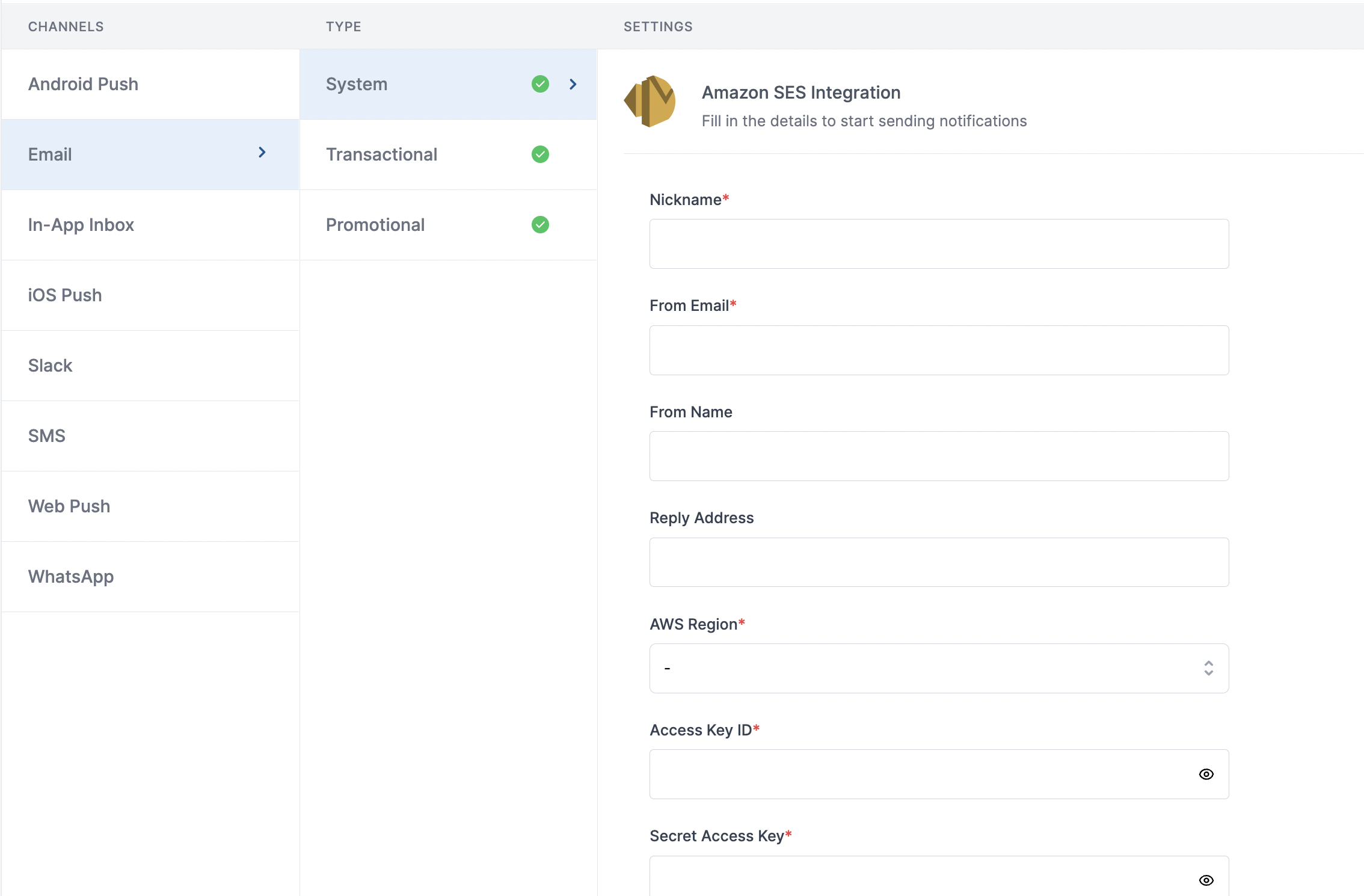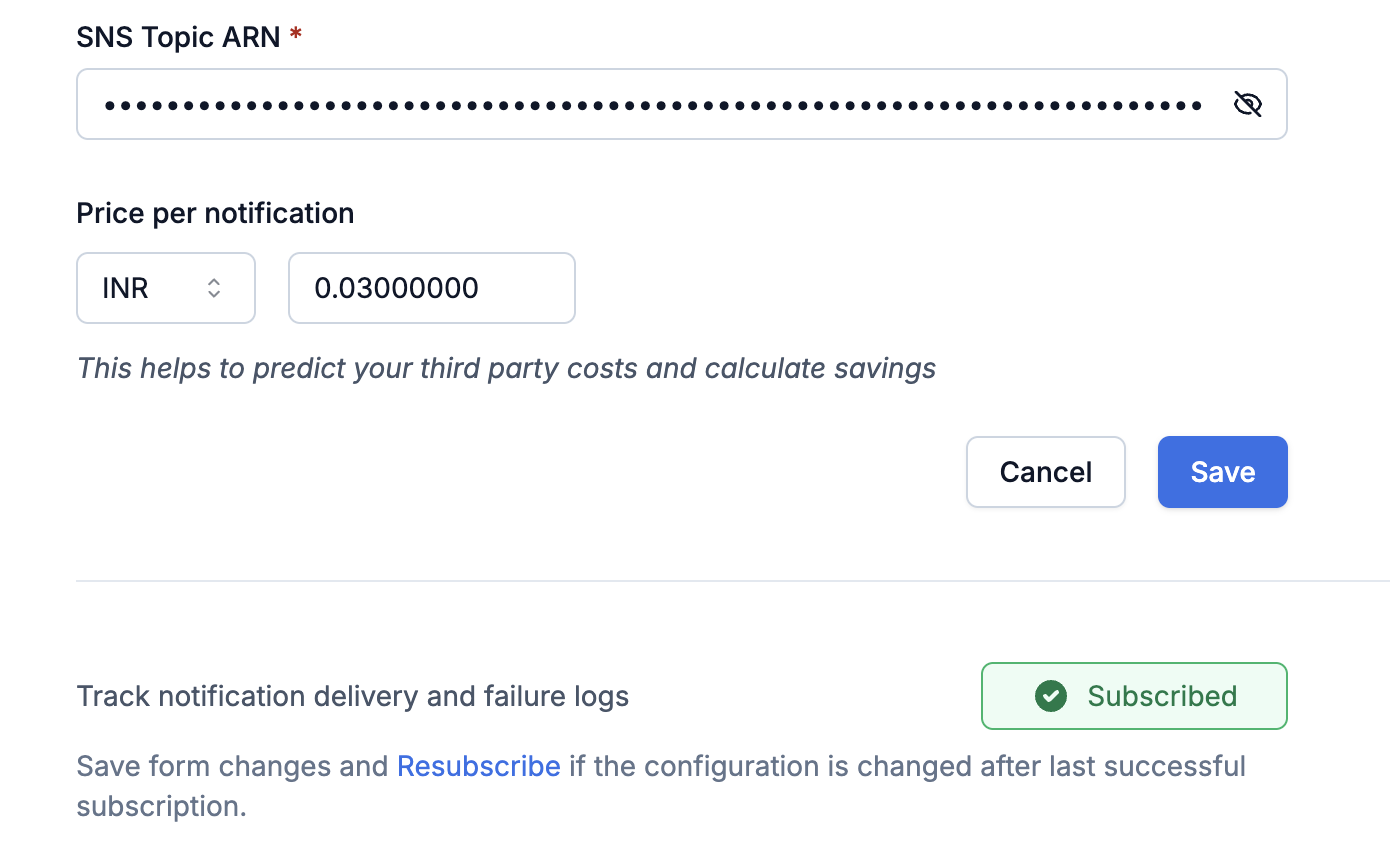Pre-Requisites
Before you begin, ensure you have:- An AWS account with administrative access
- Necessary permissions to create IAM roles/users and SES resources
- Access to AWS Console
Authentication options
SuprSend supports two authentication methods for Amazon SES integration:IAM Role (Recommended)
IAM Role-based authentication is the recommended approach as it:- Provides temporary, scoped access
- Eliminates the need for long-term credentials
- Follows security best practices
Creating IAM Role
Creating IAM Role
1
Create Policy
If you’re using IAM-role authentication at multiple places inside SuprSend, you can consolidate all permission statements within a single policy.
- Navigate to IAM console.
-
Select
Policiestab. -
Click
Create Policy. -
Either use a ‘Visual-editor’ or a ‘JSON editor’ to allow actions
["ses:SendEmail", "ses:SendRawEmail"]. For simplicity, choose “JSON editor” and replace the existing content with below JSON. -
Name your policy (e.g.
suprsend_trust_role_policy). - Add an optional description.
-
Click
Create Policy. This will create a policy with the above permissions.
2
Create IAM Role
- Go to IAM console →
Rolestab - Click
Create Role - Select
Another AWS Accountas trusted entity - Enter SuprSend’s AWS account ID:
924219879248 - Select the policy created in step 1
- Name your role (e.g.
suprsend_trust_role) - Review and create the role
3
Verify Role Configuration
- Navigate to your created role
- Check Trust Relationships tab
- Verify the trust policy matches:
Important:
- Principal must be SuprSend’s AWS account ID: “924219879248”
- ExternalId should match the unique ID entered during role creation
- Save the following information for SuprSend setup:
- Role ARN
- External ID
- Maximum session duration
Creating IAM User
Creating IAM User
Follow these steps to create an IAM user with programmatic access:
- Create an IAM user with Programmatic access
- Attach
AmazonSESFullAccesspolicy - Save the
Access-key-IDandSecret-Access-Keysecurely
Make note of your AWS region (e.g.
ap-south-1) as it will be needed for configuration.Integration steps to connect AWS SES with SuprSend
1
Create SES Verified Identity
- Open AWS SES console
- Navigate to
Verified Identitiestab - Add and verify either:
- An email address
- A domain/subdomain
- Follow AWS documentation for detailed steps
2
Create Configuration Set
Configuration-set is a rule set applied to send-email. In configuration-set you can specify to track events (e.g. send, delivery, open, click, bounce, complaint etc.) and send these to an event destination. Refer to the documentation on how to create configuration sets.
- Go to SES console →
Configuration sets - Click
Create set - Configure:
- Name:
ses_suprsend_configset - IP Pool: Select your pool or use
default
- Name:
- Click
Create Set
3
Manage Event Destinations
Event destinations are used to send email delivery events to SuprSend for tracking notification status (send, delivery, open, click, bounce, complaint etc.) for logs and analytics. To setup event destination,
- Select your configuration set
- Go to
Event Destinationstab - Click
Add destination - Configure:
- Event Types: Select all
- Destination Type: Amazon SNS
- Enter a destination Name. e.g.:
ses_suprsend_configset_destination - Make sure
Event publishingis markedEnabled. - Select an SNS topic from the dropdown (or create a new topic) for events destination.
- Review and add destination
4
Configure SNS Topic Permissions
After setting up the configuration set and SNS topic for email events, you’ll need to grant SuprSend permission to subscribe to your SNS topic. This is done through AWS’s cross-account SNS subscription feature, which allows external AWS accounts (like SuprSend’s) to receive notifications from your SNS topics. For detailed information about cross-account SNS subscriptions, see the AWS documentation.
- Go to SNS Console → Topics
- Select the topic created in previous step
- Edit Access Policy
- On the edit page, expand the
Access Policysection. The policy looks something like below. You’ll notice that the current policy givessns:Publishpermission to your SES account.
5
Add policy to give`sns:Subscribe`permission
Next you need to add a policy to giveSo in effect, the whole policy would look like this. Verify the policy and click on
sns:Subscribepermission to SuprSend (Account: 924219879248). Add below json inside theStatementlist: (replace the “Resource” value with your “Resource” value)Save.6
Fill Vendor settings page on Suprsend
On the SuprSend dashboard, go to vendor page from side panel and click Email -> Amazon SES from the list of Vendors. This will open vendor details page as shown below:

| Form Field | Description |
|---|---|
| Nickname | You can give any name which may help you to identify this account easily. E.g. - AWS SES [Production] |
| From Email | Default ‘From Email ID’ that email will go from. You can override this in the individual template.*e.g. [email protected] |
| From Name | Default ‘From Name’ that email will go from. You can override this in the individual template.e.g. SuprSend |
| Reply Address | Default ‘Reply To Email id’ on which replies are received. You can override this in the individual template.*e.g. [email protected] |
| AWS region | aws-region you are going to use for sending emails. |
| Access Key ID | Access key ID of the IAM user with full access. Refer step to create a new IAM user and generate access key. |
| Secret Access Key | Secret-Access-Key of the IAM user with full access. Refer step to create a new IAM user and generate access key. |
| Configuration Set | Configuration-set is used to track email events (e.g. send, delivery, open, click, bounce, complaint etc.). Refer Step to define configuration set. |
| SNS Topic ARN | This is the destination where the tracked events will be sent. Configuration set defines what events to be tracked and setting the topic allows SuprSend to receive these events. Follow step 4 & 5 to setup SNS topic and give SuprSend permission to subscribe to it. |
| Price per notification | This is the amount you pay per email notification to AWS. It helps us to calculate, estimate and optimise your cost spent on notifications. |
Setting Amazon SES event tracking
One of the platform advantage of using SuprSend as a central communication system is that it shows notification analytics for all channels in your SuprSend account together. For enabling event tracking at SuprSend (such as delivery, opened, blocked, spam etc.), you’ll have tosns:Subscribeaction to SuprSend.
Once you’ve filled in the required fields and saved your changes on the vendor configuration page in the SuprSend platform, you’ll need to manually click the Subscribe button to initiate the subscription to your specified SNS Topic ARN. This step is necessary to enable Email Tracking and ensure that notification delivery and failure logs are properly tracked.
If any changes are made to the SNS configuration after a successful subscription, you can click the Resubscribe button to re-establish the subscription using the latest configuration. This ensures your email tracking setup stays consistent and up to date.
Successfully Subscription as:

